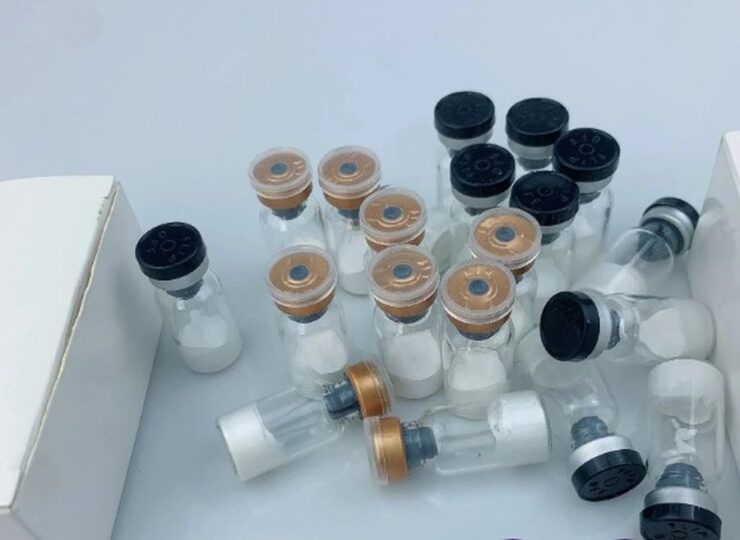The topic of this article will revolve around the PE-22-28 peptide and the extensive neurogenesis research it has been a part of.
The naturally occurring protein spadin is the natural ancestor of the synthetic compound PE-22-28. Studies suggest that the naturally occuring peptide known as Spadin is generated from the protein sortilin, which is found in high quantities in the central nervous system. PE-22-28 peptide is an abbreviated peptide derivative of this protein; the study suggests that, like Spadin, it may largely work through the TREK-1 receptor. PE-22-28 peptide is one such shortened peptide derivative.
TREK-1, also known as the TWIK-related potassium channel receptor, is a two-pore potassium channel that was only recently discovered to be a possible target for alleviating the symptoms of depression. The year 2010 saw research publication [ii] suggesting that rats with their TREK-1 receptors deleted may become less susceptible to depressive activities after the procedure. The prefrontal cortex and the hippocampus, brain regions regulating mood, memory, and learning, are where TREK-1 receptors are most often located in the brain. The TREK-1 receptor may be simulated, leading to decreased neuron excitability. On the other hand, decreasing the activity of the receptor can lead to increased neuron excitability. This receptor is most often employed in research on the creation of antidepressants; nevertheless, it is also critically important in anesthesia, the experience of pain, and the protection of neurons.
PE-22-28 Peptide Overview

Research [i] in animal test models has suggested that naturally occurring Spadin may block the TREK-1 channel, perhaps producing antidepressant effects for a predetermined time. Researchers have done several experiments on Spadin derivatives and analogs to increase the substance’s bioavailability and stability. One such investigation was carried out on several Spadin compounds containing seven amino acids, given the name PE-22-28. Similar to Spadin, PE-22-28 is a synthetic derivative that researchers speculate may bind to the TREK-1 channel, inhibiting activity and leading to improved mental steadiness as an effect.
Since the invention of the peptide, research investigations have covered a wide variety of potential applications, including the following:
- Possible antidepressant properties
- The possibility of an enhancement in the control of neurogenesis
- Possible enhancements to muscular function
- Probable nootropic properties
Additionally, the peptide may display the following characteristics, as suggested by studies:
- Possibly increased steadiness in comparison to Spade
- Potentially have a quicker onset of action than other supposedly TREK-1-blocking antidepressants with comparable names
- A half-life that is potentially longer than the naturally occurring Spadin
PE-22-28 Peptide Research and Scientific Investigations

PE-22-28 Peptide and Depression
Scientists consider the positive correlation between depressive behavior and activity, and the reduced size of the hippocampus. Researchers hypothesize that when the PE-22-28 compound is presented, the decreased volume has a better chance of being reversed and returned to an appropriate level, ultimately possibly reducing depressive episodes. The researchers speculate that the peptide may stimulate neurogenesis, a hypothesis supported by the mechanism of the cAMP signal cascade.
PE-22-28 Peptide and Post-Stroke Depression (PSD)

Spadin peptide or selective serotonin reuptake inhibitor (SSRI) antidepressants were presented to experimental mice that had PSD syndrome created in them as part of a research study [iii]. The animals had the syndrome because they were given SSRI antidepressants. An antidepressant known as an SSRI, which stands for selective serotonin reuptake inhibitor, is thought to work by obstructing the reabsorption of serotonin neurotransmitters. Even though both compounds were said to have improved the mice’s condition, SSRIs were speculated to have generated a wide variety of extra activities. Studies suggest that, at the same time, the PE-22-28 peptide did not seem to have this effect. Reports suggest the SSRI molecule required more time before it exhibited any impact, but the peptide seemed to function quickly.
PE-22-28 Peptide and Neurogenesis
The findings of certain studies suggest the peptide could be responsible for neurogenesis (the development of neurons) and synaptogenesis (the production of synapses). Spadin derivatives were detected in the neuron cultures of mice in several studies that were carried out. One research study suggests further activation of the MAPK and PI3K pathways occurs, which may result in neuron protection and development. The second research suggested that the peptide may raise the brain-derived neurotrophic factor (BDNF) concentration and the mRNA expression of the factor in the hippocampus.
It is generally agreed that the hippocampus enhances learning and memory. Therefore, research suggests that the peptide PE-22-28 may possess nootropic properties, with putative actions taking place in the area of the hippocampus. Scientists hypothesize some creatures may show probable signs of age-related downregulation of CREB activity in the brain, also known as cAMP response element binding activity, when they reach a specific age. It is speculated that CREB may be essential for the expansion and creation of neurons, and it may also play a role in the development of memory and neural plasticity.
Peptide PE-22-28 and Muscle Function

It is generally speculated that the TREK-1 receptor may also affect the capacity of muscles to react in response to external stimuli. Several scientific reports suggest that activating this receptor may cause the muscles to become relaxed; conversely, inhibiting the receptors may result in the opposite effect, causing the muscles to contract. Based on this, further research on the PE-22-28 peptide is being conducted to understand better its possible effects on the relaxation and contraction of the muscle.
More study is needed to understand its potential applications in science fully. PE-22-28 peptide is restricted to usage in research and educational institutes. The website biotechpeptides.com is a great resource for licensed researchers to procure research peptides. Sales are restricted to verified professionals and active scientists, and the compounds mentioned here are strictly prohibited for individual or human use. This article’s information is meant only for educational purposes.
Related Posts:
- 15 Best Dog Food For Allergies 2024 - Adult, Puppy…
- 15 Best Dog Food For Pitbull 2024 - Responsible Pet Care
- 20 Best Gaming Headset Under 50$ 2024 - for PC, PS4,…
- Top 10 Best Outdoor Basketball Shoes 2024 - Durable…
- Unveiling the Mystery: Can Jewelers Really Tell if a…
- 15 Best Shoes for Jumping Rope 2024 - Maintain a…







